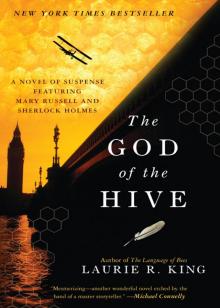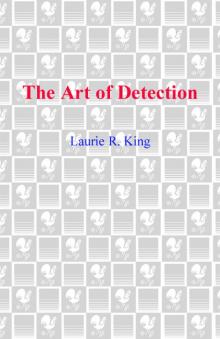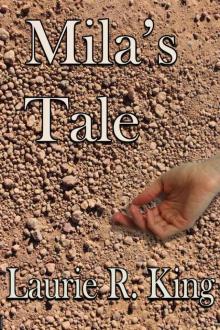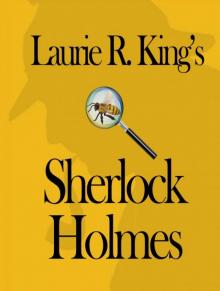- Home
- Laurie R. King
The Language of Bees Page 10
The Language of Bees Read online
Page 10
The woman was Irene Adler.
The date in the corner was 1910. Damian had been sixteen years old. She died two years later.
There followed a series of small sketches of French streets: a market, the Seine as it went through Paris, an old man snoozing on a park bench. Three of the five were dated, all of them before Irene Adler's death.
Then came the shock: With one turn of the page the viewer stepped from an empty street with interesting shadows to a front-line trench under fire. The trench walls loomed high and threatening, as if the pit were about to swallow the figures within; the moon high in the heavens seemed to taunt. At the centre, a man cowered, wrapping his body around his rifle like a terrified child embracing a doll; the man beside him gripped the brim of his helmet with both hands, as if trying to pull it down over himself; to the right of the drawing stood a young man, head thrown back and arms outstretched in a stance that could have been sexual passion or the agony of crucifixion. The paper the scene had been drawn on was grimy with dried mud and held together by gummed tape.
There were seven war-time drawings in all. Although none were dated, their order was easy to determine, because the style grew increasingly precise as time passed. The last one, a close study of the upper half of a naked skull emerging from the mud, possessed the finely shaded detail of a photograph.
In all of the war-time sketches, the perspective was odd, the objects to the sides tending either to loom up, or to curl in towards those in the centre, as if the artist saw the entire world as threatening to engulf him.
The page following the skull was startling in a different way, being in colour. It and the rest were all photographs, most of them coloured, of paintings, bearing dates between 1917 and 1919. The quality and uniformity of the photographs suggested that all had been made at the same time. Probably, I thought, either at the instruction of Mme Longchamps, or by another following her death.
I had thought the bee tea-pot unsettling: It was nothing compared to these images.
The thirty or so pages remaining in the album, a closer examination showed, were taken from only nine originals. Each sequence began with the complete painting, the size of which seemed to vary, followed by several closer-up parts of the whole.
Some of the paintings were violent, showing dismembered bodies and wide pools of blood, every glistening inch painted with loving detail. Others were nightmare horrors: a woman with full breasts, delicious skin, and an oozing sore for a mouth; a child clutching a human heart, its veins and arteries trailing to the ground. A painting done in June 1918 showed a room in what could only be the mental hospital where Damian had been treated: a study in pallor, white-grey beds, white-pink curtains, a man with white-brown skin wearing a white-blue dressing gown, a patch of white-yellow sun hitting the white-tan floor: The painting felt like the moments under ether when consciousness fades.
All the paintings felt tortured. All were disturbing. The earlier ones had more overt depictions of the macabre, the latter images felt as though a horror lay just outside the room, but each painting seemed to be holding its breath in dread.
The last painting was a family portrait: father, mother, child. The mother, in the centre, was Irene Adler. The child on her left was a thin boy with grey eyes. The man on her right was Holmes. The figures were posed as if for a conventional portrait, facing the artist, the father standing behind the seated mother, the boy leaning into her lap in a pose that resembled a pietá. The wallpaper behind them faded at the top, merging into a dark, starlit sky: Above the man's head was a tiny sun, weak with immeasurable distance; above the mother rode a gravid-looking moon; over the son flew a streaking comet. At the bottom, wallpaper met carpet, but when one studied the odd colouring and perspective, it suddenly became clear that all three figures had begun to melt into the carpet, the colours of their clothes bleeding into its weave, their shoes no longer even an outline against the pattern.
Its date was October 1919. Damian had painted this after meeting Holmes, and shortly before he had left France entirely.
A celestial family bleeding into the ground: In another hand, it would have been mere Surrealist trickery, but here, one received the clear impression that beneath the calm of their faces, each of the three could feel what was happening, and that the process was on the edge of excruciating.
I looked out of the window, and saw that the sun had long since set. I closed the book, put it on the shelf, shut the library door, and even rattled the knob, to make sure the latch had caught. If there had been a bar across the door, I would have dropped it into place as well.
The sitting room's dark corners seemed to crawl with unknown threat. I poured myself a glass of brandy—odd, how much I had drunk the past couple of days—and picked up a travelling rug on my way out to the terrace. The moon would be full tonight, and the sky was so clear, I could practically read a newspaper. I spread out the rug on the deck-chair, and lay back to watch the sky. Perhaps I would see the occasional meteor, trailing after Tuesday's height.
My mind was both empty and occupied, all of the thoughts buzzing far below the surface. So it was not for some time that I realised that I had come out onto a dark terrace, and that I could not see my feet at the other end of the deck-chair. It was remarkably dark, yet the stars shone. Where was the moon?
I looked to the east, expecting to see its great mass slowly pulling above the horizon, but it was not there. In its place was a slim crescent, perhaps two days old.
My brain felt like a motor slapped abruptly into reverse. But the moon was full. I'd slept on this very spot not two nights past, and it was big and growing bigger, all but perfectly round. How, then—?
It was in the east. A setting sun, with a new moon in the east?
I experienced a sharp pulse of panic, convinced that Damian's macabre paintings had affected my mind in some profound way. Then I shook myself, and cast around for an explanation that incorporated the customary workings of the universe.
An eclipse.
I had read something about an eclipse recently, but nothing had prepared me for one here. An advert, that had been, for a boat tour to the eclipse. Why would one take a boat tour when one could sit anywhere in the country and see the moon fade?
I stared up, open-mouthed, as the last of the moon was overcome, and all one could see was a faint circular object in the sky, as much an absence of stars as a presence of a celestial body. It stayed dark for a long, long time, nearly an hour, before a faint suggestion of curve appeared. Shortly after ten o'clock, the earth's satellite began to move out of the planet's shadow: a thin curve; a fatter slice; a bulging half-circle; finally, an hour later, it was glorious and round; an hour after that, it was fully brilliant.
As I had felt a primitive's fear at the moon's disappearance, so I felt the profound reassurance of its return. Once the moon was securely in the sky, I went inside, less troubled by the images behind the library door. I slept that night, long and deep.
The Seeker (1): An artist grinds lapis to make blue,
lead to make white, giving colour and dimension to the
artifice on his canvas. How not to spend his entire career
inventing techniques known by the painters who
have gone before?
Testimony, I:8
DAMIAN? DAMIAN, WAKE UP! DA—”
“Bloody bastard, watch out for the—oh, I'll bloody murder you, you son of a—”
“Damián!”
“What? What is it?”
“The light burnt out, you were having a dream. A nightmare.”
“Don't be an idiot. I don't have nightmares.”
“Then you were locked in battle against invisible foes. Here, I've turned on the other lamp. Are you all right?”
“Of course I'm all right. I just need some air.”
“The window is open.”
“I have to get out.”
“Damian—”
“If you try and stop me, I'll hit you.”
“I wasn't
going to stop you. But tomorrow? We'll divide up.”
“Now there's a pity.”
“And, Damian? Take your coat. You're dripping with sweat.”
The Seeker (2): Every man, however god-like and gifted,
requires a Guide to set him upon the path, to show him
how other artists have achieved their results, to show how
other Seekers have found their answers.
Testimony, I:8
FRIDAY MORNING, I SAT AT THE KITCHEN TABLE, reading Thursday's papers, drinking strong coffee, and eating slices of stale bread covered with butter and jam—I'd become somewhat tired of honey, and had decided that a more substantial breakfast was not worth the effort of clearing smoke and scraping pans. Mrs Hudson would be back tomorrow, and life would return, at least in part, to normality.
I stood at the door looking over the terrace and the Downs, and thought about what to do with my last full day of solitude. There was no telling where Holmes was or when he might appear, but when he did so, it would be satisfying to have solved his mystery for him.
I put on my boots, locked up, and set off once more in the direction of the mad beehive.
Once there, I left my rucksack in the shade of the emptied Langstroth box and walked due east, going nearly half a mile before turning back to where I had started. I walked slowly, searching the ground, the air, the surroundings in general, to see what was different about this particular hive.
Back and forth I went, my senses open to that one lonely patch of downland. I climbed over stone walls, poked about in holes looking for poison bait, wrote down the name of every plant in the vicinity, the presence of sheep, the lack of trees.
After three hours, the sun was scorching and I was thoroughly fed up with the entire puzzle. I drained my last drop of warm lemonade and tried to put my thoughts in order.
There was nothing I could see that set this hive apart from the others. Except that it was, in fact, apart, this being the furthest of Holmes' hives. As yesterday's blistered palms could well testify.
Plenty of food—the honey in the frames had told me that. A fertile queen—any number of fertile queens. So what was it? Why dislike this place? What had so infected the community with alarm and despondency that they had deserted their brood?
With a sigh of resignation at my own unwillingness to let go of the conundrum, I got down on my hands and knees at the front of the hive and picked through the grass with my fingertips.
There were dead bees there, of course—workers only live a few weeks, and a sentimental burial is not in the hive's interest. Still, I dutifully gathered up those that were not dried to a husk, taking care not to impale myself on the stingers, and folded them into a sheet of paper. Perhaps examination under a microscope would reveal a parasite.
When I was finished, I climbed onto the wall and gazed at the slopes running down to the Channel. The water was blue today beneath the summer's sun; I counted twenty-three vessels, from light sail-boat to heavy steamer, in the patch immediately before me.
Not so this piece of hillside. Even in August, this was away from the shoes of long-distance ramblers and day-tourists alike. The nearest house was almost a mile away, the grassland was broken by nothing larger than gorse bushes.
A small and tentative idea, born of the loneliness of the place and three days of my own solitude, crept into the side of my mind. I looked speculatively down at the packet of bees.
Then I hopped down from the wall and went back to the house. I spent some time with the more scientific manuals on bees, until I was certain that they were all workers, then went to the honey shed to retrieve one of the frames containing queen cells. I wrapped it with care, laid it in my bicycle basket, and set off for Jevington, where Mr Miranker's letter had come from.
A woman tossing grain to her chickens directed me to the beekeeper's house, on the far edge of the village. I spotted the man himself over the wall, gathering windfalls from beneath the apple tree. He looked up, unsurprised to see me.
“Good day, Mrs Holmes.”
“Hello, Mr Miranker.”
“I'm trying to pick up the apples before the wasps find them,” he explained. “I don't like to encourage wasps to spend time in the vicinity of the bees.”
“Quite,” I answered, remembering belatedly, and with some guilt, that Holmes had once told me something of the sort. As if to make up for my own poor husbandry of the bees left to my keeping, I bent to help him clear his apples.
“Was there something I might do for you?” he asked after a while.
“Oh, yes,” I said. I dropped my load of bruised and spoiling fruit in the barrow and fetched the frame from my bicycle. He led me to a sunlit potting bench and moved away the collection of clay pots and gravel. I dusted off the boards and laid out my frame.
“I wonder if you can tell me anything about these queen cells?”
“Apart from the fact that they are empty?”
“Can you tell if they were opened from inside, or from without?” I had brought the magnifying glass, but he did not take it.
He picked up the frame, tilting it back and forth to the sunlight, while I told him my speculations.
“The hive is all by itself on the hillside. The nearest hive is nearly a mile away. Here's what I was wondering.” And I laid out for him the story I had built in my mind.
When a hive swarms, the reigning queen takes with her the better half of the hive, leaving behind the honey, an entire hive's worth of infant workers in their cells, and one or several potential queens. The workers who remain behind nurture the queen cells until the first one hatches, at which point she tries to slaughter her potential rivals. Generally, the hive prevents her from killing all of them until she has returned successfully from her mating flight, ready to take up her long life as the centre of the hive's future.
The hours that she is away is a time of enormous vulnerability for the hive. A hungry bird, a chill wind—and their future fails to return. And if her hive has permitted her to kill all potential rivals, they are doomed.
The summer had seen periods of wet, and wind was always a problem near the sea, but I wondered if the remoteness of the hive had driven the queen to take a longer nuptial flight than normal, before the drones from her own and other hives caught her up.
I was not going to go so far as to suggest that loneliness had killed them, but that was the underlying idea.
Mr Miranker listened to this, radiating doubt as he methodically went over the frame I had brought him.
I asked him, “How do the drones know that the new queen is taking off?”
“There is, literally, a hum of anticipation that builds throughout the hive. And the queen sings, quite loudly. Then, once she is in flight they simply see her—she generally chooses a clear day on which to fly. It is also possible that she ‘speaks’ by sounds inaudible to human ears, or by her motions, or even by emitting an entire language of smells.”
“How far can a drone fly?”
“Bees can fly two or three miles.”
“What would happen if something kept her own drones from reaching her?”
Miranker glanced sideways at me, realising that he was discussing the mechanics of apian sex with a woman young enough to be his granddaughter. He cleared his throat, and replied gamely, “Generally speaking, drones from hives all around respond to the call of a virgin queen. Hundreds, even thousands of them.”
“And if there were no other hives nearby?”
“There are always other hives nearby.”
“As far as I can see, the nearest bees to that hive are those in our orchard, more than a mile away.”
Miranker stared at me. “Are you suggesting that the queen's flight went, er, unconsummated?”
“Is that possible?”
“It is more likely that she did not return at all. That is why the hive produces a number of queen cells, in anticipation of failure.”
“But if she was too bloodthirsty for them? If they didn't stop h
er from killing her rivals?”
“Then it might well be too late for them to raise up another from the eggs left by the previous queen.” But just as I was thinking that I had succeeded in solving Holmes' mystery, he said, “However. These cells have been opened from within.”
“What, all of them?”
“The five I see here. How many were there in all?”
“Twenty-one. They all looked pretty much—”
“Twenty-one? All like this?”
“As far as I could see.”
“I should say that all of these hatched.”
“You mean, this hive has made twenty-one queens? Every one of them hatched, and fighting for primacy?” Absolute chaos, if that was the case.
“More likely, hatched and flying off into the blue. In some hives, the difference between a cell intended for swarming and one intended for supersedure—replacing the queen—is clear. Here, I would not be so certain.”
“So, one after another, the queen cells hatched and led a swarm?”
“Yes. However, you see this frame here? The brood?”
“Unhatched bees?”
“And eggs?”
When he pointed them out to me, I could see them. “What does that mean?”
“It means the queen was active until quite recently. Certainly there was a queen in residence when I last checked the hive, three weeks ago.”
“So all this happened in the last three weeks? Twenty-one swarms?”
“No, the swarms took place beforehand. And that is the peculiar thing. Your hive had an active queen, and yet continued to hatch virgin queens, time and again. And not only did she not kill them, she did not lead any of the swarms. Just kept laying while the hive swarmed around her.”
“Did the workers keep her from killing them?” A hive madness, indeed.
“In their decreasing numbers? I should be surprised if they could.”
“Then what happened?”

 O Jerusalem
O Jerusalem Beekeeping for Beginners
Beekeeping for Beginners The God of the Hive
The God of the Hive The Language of Bees
The Language of Bees Night Work
Night Work Justice Hall
Justice Hall The Murder of Mary Russell
The Murder of Mary Russell Lockdown
Lockdown To Play the Fool
To Play the Fool Locked Rooms
Locked Rooms Island of the Mad
Island of the Mad The Art of Detection
The Art of Detection The Mary Russell Series Books 1-4
The Mary Russell Series Books 1-4 The Beekeeper's Apprentice
The Beekeeper's Apprentice For the Sake of the Game
For the Sake of the Game A Darker Place
A Darker Place Mila's Tale
Mila's Tale Mrs Hudson's Case
Mrs Hudson's Case With Child
With Child The Marriage of Mary Russell
The Marriage of Mary Russell The Mary Russell Companion
The Mary Russell Companion Hellbender
Hellbender Castle Shade
Castle Shade The Bones of Paris
The Bones of Paris Riviera Gold
Riviera Gold A Grave Talent
A Grave Talent Pirate King
Pirate King Dreaming Spies
Dreaming Spies Folly
Folly Touchstone
Touchstone The Game
The Game The Mary Russell Series Books 1-4: The Beekeeper's Apprentice; A Monstrous Regiment of Women; A Letter of Mary; The Moor
The Mary Russell Series Books 1-4: The Beekeeper's Apprentice; A Monstrous Regiment of Women; A Letter of Mary; The Moor The Moor mr-4
The Moor mr-4 The Birth of a new moon
The Birth of a new moon With Child km-3
With Child km-3 A Letter of Mary mr-3
A Letter of Mary mr-3 Justice Hall mr-6
Justice Hall mr-6 Pirate King: A novel of suspense featuring Mary Russell and Sherlock Holmes
Pirate King: A novel of suspense featuring Mary Russell and Sherlock Holmes Pirate King: A novel of suspense featuring Mary Russell and Sherlock Holmes mr-11
Pirate King: A novel of suspense featuring Mary Russell and Sherlock Holmes mr-11 Beekeeping for Beginners (Short Story)
Beekeeping for Beginners (Short Story) Laurie R. King's Sherlock Holmes
Laurie R. King's Sherlock Holmes Echoes of Sherlock Holmes
Echoes of Sherlock Holmes A Study in Sherlock
A Study in Sherlock The Game mr-7
The Game mr-7 Garment of Shadows: A Novel of Suspense Featuring Mary Russell and Sherlock Holmes
Garment of Shadows: A Novel of Suspense Featuring Mary Russell and Sherlock Holmes Dreaming Spies: A novel of suspense featuring Mary Russell and Sherlock Holmes
Dreaming Spies: A novel of suspense featuring Mary Russell and Sherlock Holmes Night Work km-4
Night Work km-4 Mary Russell's War
Mary Russell's War To Play the Fool km-2
To Play the Fool km-2 A Monstrous Regiment of Women mr-2
A Monstrous Regiment of Women mr-2 O Jerusalem mr-5
O Jerusalem mr-5 A Grave Talent km-1
A Grave Talent km-1